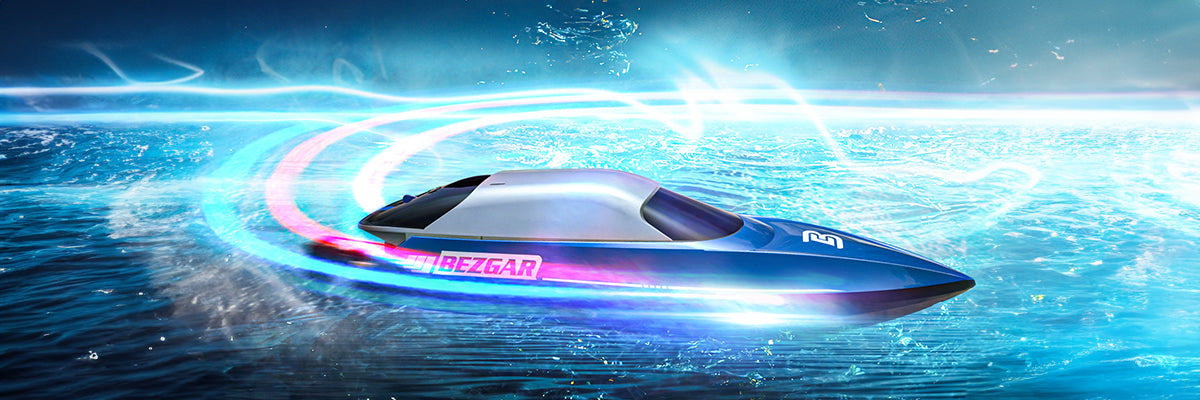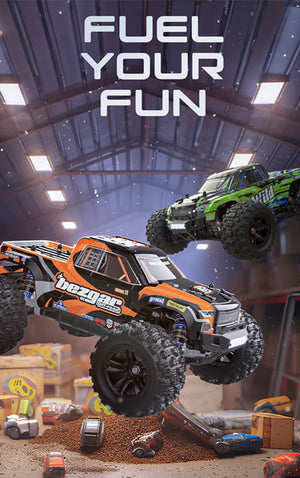
A 2024 Guide to Exploring RC Boat Controls and Power Systems
Have you felt the rush of steering a speedy RC boat across a pond? If not, you're missing out! Once you join the growing community of RC boating fans, it becomes about more than just controlling a mini machine - it's about the joy of the hobby.
Think of your boat as a little world you can navigate and explore. The ability to control your vessel is powerful!
But before jumping in, let's review some key things - the boat's controls and power systems. Understanding these basics will help you command your boat skillfully, not just move it around. With this core knowledge, you'll be ready to captain like a pro!
We're here to help explain the ins and outs of RC boat controls and power. With this info, you'll have all you need to set your RC ship sailing! Let's dive in, shall we?
Understanding RC Boat Basics
To kick things off, let's get up close and personal with the fundamentals of an RC boat, starting with the key components of your miniature vessel.
RC Boat Components: A Quick Breakdown
- Motor: The heart of your boat, providing power and speed.
- Radio: Where you communicate from, sending signals to your boat's receiver.
- Radio Gear: Includes transmitter, receiver, and servos, ensuring your boat obeys your commands.
- Batteries: The life source of your boat, powering the motor and radio gear.
With that in mind, let's set sail and decode these essential parts to truly steer your RC boat adventure:
Vital Boat Parts Unveiled
- Electric Motor: Brushed or brushless, propels your vessel forward.
- Shaft: Transfers power from the motor to the propeller.
- Stuffing Tube: Keeps the water out and allows the shaft to rotate smoothly.
- Hull: The boat's body, responsible for floatation and stability.
- Propeller: Converts motor power into thrust, pushing your boat through the water.
- Rudder: The steering master, helping you make those thrilling turns.
Now that you're acquainted with the basics, let's proceed to learn more about your boat's power and drive system!
Power Systems of RC Boats: A Friendly Face-Off
When powering your RC boat, you'll generally stumble upon two types of motors - brushed and brushless. That is where our friendly face-off begins!
Spoiler alert: They both come with their own perks and quirks, so it’ll be up to you to decide which is best for you.
So, let's dive in and see what each one offers!
Brushed vs. Brushless Motors: The Saga Continues
Brushed Motors: The Old Guard
- Pros:
- Budget-friendly.
- Simple to understand and maintain.
- Easily adjustable mechanical timing.
- Cons:
- Less efficient.
- May have a shorter lifespan due to brush and commutator wear.
Brushless Motors: The New Age Crusader
- Pros:
- Highly efficient, with more power output.
- Longer life due to lack of brushes and no mechanical wear on the commutator.
- Higher performance with speed and torque.
- Cons:
- Pricier than brushed motors.
- Requires more complex electronic speed control (ESC).
Now that the curtain's been lifted on these two rivals, you can make an informed decision on which power system suits your needs, budget, and RC boat aspirations. Remember, there's no one-size-fits-all answer; choose the motor that feels like the perfect handshake between you and your boat!
Drive Systems of RC Boats: The Power Transfer
Ever wondered about the secret sauce that helps your RC boat zip across the water? Brace yourselves, shipmates, because we're about to uncover the magic of power transfer!
Specifically, we'll dip our toes in and see how the motor transfers power to the propeller, making your boat displace water like a rockstar.
The Power Transfer Plot: Motor to Propeller
Here's how your boat's engine turns electrical energy into sweet, sweet motion:
- Your motor generates rotational energy. Believe it or not, this is where the thrilling journey starts!
- The drive shaft, connected to the motor, takes this energy and runs with it – all the way to the propeller.
- Your propeller, now fueled with transferred power, spins like a ballerina and sends your boat zipping across the water.
The Unsung Heroes - Drive Shaft and Stuffing Tube
A smooth-sailing boat owes it all to its excellent drive system, particularly the drive shaft and the stuffing tube. The drive shaft is the middleman, taking energy from your motor and delivering it to the propeller. The stuffing tube houses the drive shaft and keeps it lubricated while ensuring no water enters your boat's innards.
Remember, power transfer is the gift that keeps on giving in the world of RC boating. Keep your drive system well-maintained, and you'll have a loyal, energetic boat ready to put on a show every time!
Radio Controls of RC Boats: The Communication Upgrade
As an RC boater, one of your closest allies has to be your radio control system! Because no matter how powerful your boat is, you need solid communication to steer it right.
And boy, haven't these systems come a long way! We've leaped from 27MHz systems to the new-gen 2.4GHz systems. It's like switching from an old, cranky radio to a cutting-edge Bluetooth speaker!
What's the big win, you ask? This leap led to a significant reduction in frequency conflicts and interference, giving us smooth, seamless control over our water crusher. So, here's raising a toast to the technology that made our RC boat journey a whole lot easier and more interesting!
Battery Systems in RC Boats: The Fuel Behind the Fun
Sailing your boat rightly demands understanding battery systems. It's like feeding your boat the best energy snack! We best know this snack as either Ni-MH (Nickel-Metal Hydride) or LiPo (Lithium Polymer) batteries.
Ni-MH vs. LiPo: The Lowdown
Let's glance at these powerhouses:
- Ni-MH Batteries: They're your reliable old friends. Sturdy and durable, but a bit heavy. Their performance is dependable but shows a gradual reduction in power output as they discharge.
- LiPo Batteries: Meet the high-performance, low-weight new kids on the block. They promise consistent power throughout their discharge curve but can be pricier.
So, weigh your options- the trusty nickel-metal hydride or the flashy lithium polymer. Your choice could be the real game-changer for your RC boat adventures!
Choosing the Right Battery Charger: Power Up Right!
To enjoy pure, unadulterated boating fun, you need a reliable charger by your side. Choosing between timer chargers and peak detection chargers can influence your boat's performance and longevity. Remember, an apt charger isn't an expense but an investment ensuring continuous, worry-free sailing!
The Role of Electronic Speed Control (ESC): The Rhythm Keeper
Think of the ESC as your boat's conductor, managing the symphony of speed and power in your RC boat. Having a programmable ESC allows finer control over battery usage, ensuring you extract the maximum performance while keeping your boat's energy consumption in check. It's your ticket to smarter, faster, and efficient fun!
Final Thoughts: Sailing Safely with Bezgar
Setting up your RC boat correctly isn't just about fast speeds and winning races; it's also your ticket to minimize problems and maximize enjoyment. So, invest some quality time in understanding your miniature vessel.
Your safety matters as much as the thrill of RC boating! Avoid the temptation to swim after a stalled boat, as it can be dangerous. Use a backup retrieval method, and keep your hobby safe and exciting.
Master the ins and outs of your RC boat with Bezgar's wide range of high-quality RC boats. Trust us – their boats guarantee endless joy and adrenaline-fueled adventures!
So, what are you waiting for? Set sail with Bezgar.com and make a splash!

